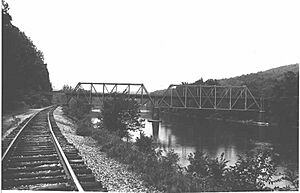Layton, Pennsylvania facts for kids
Quick facts for kids
Layton
|
|
|---|---|
| Country | |
| State | |
| County | Fayette |
| Elevation | 250 m (810 ft) |
| Time zone | UTC-5 (EST) |
| • Summer (DST) | UTC-4 (EDT) |
| ZIP code |
15428
|
Layton is a small community in Fayette County, Pennsylvania. It's called an "unincorporated community" because it doesn't have its own local government like a city or town. Instead, it's part of the larger county.
Contents
The Story of Layton
Layton used to be home to a big factory that made bricks. This was because there was a special type of clay called flint clay found nearby. This clay was perfect for making strong bricks.
Railroad Connections
Layton was also an important spot for railroads. The Washington Run Railroad connected here with the B&O Railroad. The B&O Railroad Company was one of the first to plan a railway line through the Youghiogheny and Monongahela river valleys.
In 1826, the company got permission to build a railroad from Baltimore, Maryland, through Pennsylvania to the Ohio River. They were given fifteen years to finish the project. However, they faced challenges and couldn't meet the deadline.
Building the Rail Line
Another company, the Pittsburgh and Connellsville Railroad Company, took over the plan. They started buying land and equipment. They also began building the rail line. They set up stations in different places, including Layton.
The completed rail line to Connellsville officially opened in 1855. This made it easier to transport goods and people.
How Layton Got Its Name
The land where Layton now stands was first owned by Mary Higgs in 1791. It was called "Springfield." Over the years, the land was sold to different people.
In 1821, Abraham Layton bought the land. After he passed away, his sons, Michael and Abraham Layton, used boats on the river to ship sand and glass products. Later, a special type of sand called silex, useful for making glass, was found there.
As a village grew around the railroad station, it took on the name Layton. The first store and post office were opened by Henry Brollier. Another store opened in 1876. By 1880, the area was growing, and the population of Perry Township, where Layton is located, reached 1,476 people.
The Historic Layton Bridge
In 1899, a special railroad bridge was built near Layton. It was designed by Taylor & Romine and built by A & P Roberts Co. and Pencoyd Iron Works. This bridge helped carry a road over the Youghiogheny River.
This historic bridge was added to the National Register of Historic Places in 1988. It was later changed from a railroad bridge into a one-lane bridge for cars. It connects Layton to Perryopolis and Route 51.
In July 2022, the Layton Bridge was temporarily closed for repairs. These repairs helped make the bridge and its access tunnel stronger. Officials noted that it is one of the few bridges in the area that is over 100 years old and was once a railroad bridge. Around 2025, officials planned to replace the bridge. This was to allow emergency vehicles and snow plows to continue using it safely.



